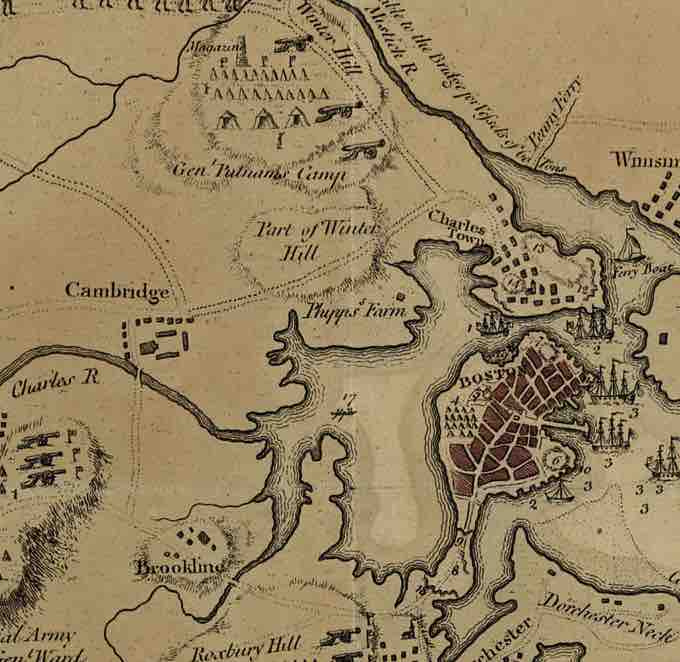Overview
The capture of Fort Ticonderoga occurred in the early stages of the American Revolutionary War when a small force of Green Mountain Boys, led by Ethan Allen and Colonel Benedict Arnold, overcame a small British garrison at the fort and looted the personal belongings of the garrison. Cannons and other armaments from the fort were transported to Boston and used to fortify Dorchester Heights, breaking the standoff at the Siege of Boston. After seizing Ticonderoga, a small detachment captured the nearby Fort Crown Point on May 11. Seven days later, Arnold and 50 men boldly raided Fort Saint-Jean on the Richelieu River in southern Quebec, seizing military supplies, cannons, and the largest military vessel on Lake Champlain.

Map of Boston, 1775
Detail of a 1775 map of Boston, with Dorchester Heights at the bottom right: "A plan of the town and harbour of Boston and the country adjacent with the road from Boston to Concord, shewing the place of the late engagement between the King's troops & the provincials, together with the several encampments of both armies in & about Boston. Taken from an actual survey. Humbly inscribed to Richd. Whitworth by J. De Costa; C. Hall, sc."
The Capture of Fort Ticonderoga
Background
In 1775, Fort Ticonderoga's location did not appear to be as strategically important as it had been in the French and Indian War, when the French famously defended it against a much larger British force in the 1758 Battle of Carillon. After the 1763 Treaty of Paris, in which the French ceded their North American territories to the British, the fort was no longer on the frontier of two great empires, guarding the principal waterway between them. The French had destroyed the powder magazine when they abandoned the fort, and the fort had fallen further into disrepair since then. In 1775, it was garrisoned by only a small detachment of the 26th Regiment of Foot, consisting of two officers and 46 men, many of whom had limited duties because of disability or illness.
After the war began with the Battles of Lexington and Concord on April 19, 1775, the British General Thomas Gage realized the fort would require fortification; simultaneously, several colonists had the idea of capturing the fort. Benedict Arnold had frequently traveled through the area around the fort and was familiar with its condition, manning, and armaments. En route to Boston following news of the events of April 19, Arnold mentioned the fort and its condition to members of Silas Deane's militia. Ethan Allen and other patriots in the disputed New Hampshire Grants territory also recognized the fort's value, as it played a role in the dispute over that area between New York and New Hampshire. On May 3, Arnold was given a colonel's commission by the Massachusetts Committee and authorized to command a "secret mission" to capture the fort.
Colonial Forces Assemble
Arnold departed immediately after receiving his instructions and reached the border between Massachusetts and the Grants, where he learned of the recruitment efforts of the Connecticut Committee and that Ethan Allen and the Green Mountain Boys were already on their way north. Riding quickly northward, Arnold intercepted Allen in time to join a war council, where he made a case to lead the expedition based on his formal authorization to act from the Massachusetts Committee.
On May 9, the men assembled at Hand's Cove and were ready to cross the lake to Ticonderoga. As dawn approached, Allen and Arnold became fearful of losing the element of surprise, so they decided to attack with the men at hand rather than wait for reinforcements. The only sentry on duty at the south gate fled his post after his musket misfired, and the Americans rushed into the fort. The patriots then roused the small number of sleeping troops at gunpoint and began confiscating their weapons. No one was killed in the assault. Eventually, as many as 400 men arrived at the fort, which they plundered for liquor and other provisions.
Noble Train of Artillery and the Fortification of Dorchester
In July of 1775, the fort was used as the staging ground for the invasion of Quebec that was launched in late August. Around the same time, General George Washington, commander-in-chief of the Continental Army since June 15, identified that one of the significant problems of the army was a lack of heavy weaponry, which made offensive operations virtually impossible. Washington eventually chose the young Henry Knox to transport heavy weaponry that had been captured at Fort Ticonderoga to the Continental Army camps outside of Boston. In an expedition that became known as the "noble train of artillery," Knox went to Ticonderoga in November of 1775, and, over the course of three winter months, moved 60 tons of cannons and other armaments by boat, horse and ox-drawn sledges, and manpower. This "noble train" traveled along poor-quality roads, across two semi-frozen rivers, and through the forests and swamps of the lightly inhabited Berkshires to the Boston area.
General Washington used the Fort Ticonderoga cannons to fortify Dorchester and force the evacuation of the British from Boston. Washington positioned these cannons on the hills overlooking both the fortified positions of the British and Boston Harbor, where the British supply ships were anchored. The British could not return fire on the colonial positions because they could not elevate their cannons. They soon realized that they were in an untenable position and had to withdraw from Boston. On March 17, 1776, the British evacuated their troops to Halifax, Nova Scotia, ending the nearly year-long siege.
Ethan Allen at Fort Ticonderoga
An 1875 print by John Steeple Davis giving an idealized and inaccurate depiction of Ethan Allen demanding the fort's surrender.